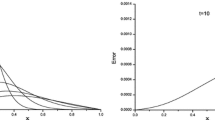Abstract
We integrate optimal quadratic and cubic spline collocation methods for second-order two-point boundary value problems with adaptive grid techniques, and grid size and error estimators. Some adaptive grid techniques are based on the construction of a mapping function that maps uniform to non-uniform points, placed appropriately to minimize a certain norm of the error. One adaptive grid technique for cubic spline collocation is mapping-free and resembles the technique used in COLSYS (COLNEW) [2], [4]. Numerical results on a variety of problems, including problems with boundary or interior layers, and singular perturbation problems indicate that, for most problems, the cubic spline collocation method requires less computational effort for the same error tolerance, and has equally reliable error estimators, when compared to Hermite piecewise cubic collocation. Comparison results with quadratic spline collocation are also presented.
Similar content being viewed by others
References
A. B. White SuffixJr (1979) ArticleTitleOn selection of equidistributing meshes for two-point boundary-value problems SIAM J. Numer. Anal. 16 IssueID3 472–502 Occurrence Handle0407.65036 Occurrence Handle83e:65138
U. Ascher J. Christiansen R. D. Russell (1979) ArticleTitleA collocation solver for mixed order systems of boundary value problems Math. Comp. 33 IssueID146 659–679 Occurrence Handle80b:65108
Ascher, U. M., Mattheij, R. M., Russell, R. D.: Numerical solution of boundary value problems for ordinary differential equations. SIAM 1995.
G. Bader U. Ascher (1987) ArticleTitleA new basis implementation for a mixed order boundary value ODE solver SIAM J. Sci. Stat. Comp. 8 IssueID4 483–500 Occurrence Handle10.1137/0908047 Occurrence Handle88f:65118
G. F. Carey H. T. Dinh (1985) ArticleTitleGrading functions and mesh redistribution SIAM J. Numer. Anal. 22 IssueID5 1028–1040 Occurrence Handle10.1137/0722061 Occurrence Handle86h:65123
Celia, M. A., Gray, W. G.: Numerical methods for differential equations. Prentice Hall 1992.
Christara, C. C., Ng, K. S.: Optimal quadratic and cubic spline collocation on nonuniform partitions. Computing 76, 279–293 (2006) (this issue).
de Boor, C.: Good approximation by splines with variable knots {II}. Lecture Notes in Mathematics 363, 12–20 (1973). Conf. on Numerical Solution of Differential Equations.
F. N. Fritsch R. E. Carlson (1980) ArticleTitleMonotone piecewise cubic interpolation SIAM J. Numer. Anal. 17 IssueID2 238–246 Occurrence Handle10.1137/0717021 Occurrence Handle81g:65012
W. Huang R. D. Russell (1999) ArticleTitleMoving mesh strategy based on a gradient flow equation for two-dimensional problems SIAM J. Sci. Comput. 20 998–1015 Occurrence Handle99m:65179
Ng, K. S.: Spline collocation on adaptive grids and non-rectangular regions. PhD thesis, Department of Computer Science, University of Toronto, Toronto, ON, Canada, 2005. http://www.cs.toronto.edu/pub/reports/na/ccc/ngkit-05-phd.ps.gz.
Author information
Authors and Affiliations
Corresponding author
Rights and permissions
About this article
Cite this article
Christara, C.C., Ng, K.S. Adaptive Techniques for Spline Collocation. Computing 76, 259–277 (2006). https://doi.org/10.1007/s00607-005-0141-3
Received:
Revised:
Published:
Issue Date:
DOI: https://doi.org/10.1007/s00607-005-0141-3



